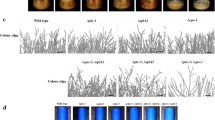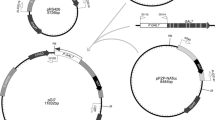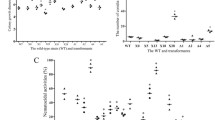Abstract
A protein synthesis inhibitor, cycloheximide, induces excretion of laccase in Neurospora crassa. The lah-1 mutation results in excretion of a large amount of laccase even in the absence of cycloheximide. Ten mutations were induced that suppress derepressed excretion of laccase in the lah-1 mutant. Of these, seven second-site mutations were found to confer a laccase-noninducible phenotype, and were classified into two different complementation groups. Four mutations define a locus designated lni-1, found to be closely linked to ylo-1 on linkage group VI. The other three mutations were mapped to second locus, designated lni-2, that lies between nic-3 and thi-3on linkage group VII. The lni-2 locus was shown to encode laccase by RFLP mapping of the DNA fragment encoding laccase and by transformation of the lni-2 mutant with plasmid pBLI carrying the laccase gene (the locus encoding laccase is hereafter described as lacc). All lacc mutants examined (whether mutagen-induced or inactivated by repeat-induced point mutation) appeared to exhibit no phenotypic deficiency during both asexual and sexual cycles, suggesting that the laccase gene is dispensable in N. crassa. Northern analysis of total cellular RNA from the four lni-1 mutants demonstrated that the lni-1 mutations abolish increased transcription of the laccase gene under inducing conditions. Consequently, the lni-1 locus is inferred to encode a trans-acting positive regulator required for transcriptional activation of the laccase gene in response to cycloheximide. Possible functions of the lah-1 gene are also described.
Similar content being viewed by others
References
Aisemberg GO, Taccioli GE, Grotewold E, Judewicz ND (1987) Differential gene expression promoted by cycloheximide in Neurospora crassa. Exp Mycol 11: 122–127
Attar RM, Grotewold E, Taccioli GE, Aisemberg GO, Torres HN, Judewicz ND (1989) A cycloheximide-inducible gene of Neurospora crassa belongs to the cytochrome P-450 superfamily. Nucleic Acids Res 17:7535–7536
Barthelmess IB (1982) Mutants affecting amino acid cross-pathway control in Neurospora crassa. Genet Res 39:169–185
Brockman HE, de Serres FJ, Hung CY (1985) Effect of the homokaryotic or heterokaryotic state of the uvs-2 allele in Neurospora crassa on mitomycin C-induced killing and ad-3 mutation. Mutat Res 150:193–202
Carsiotis M, Jones RF (1974) Cross-pathway regulation: tryptophan-mediated control of histidine and arginine biosynthetic enzymes in Neurospora crassa. J Bacteriol 119:889–892
Carsiotis M, Jones RF, Wesseling AC (1974) Cross-pathway regulation: histidine-mediated control of histidine, tryptophan, and arginine biosynthetic enzymes in Neurospora crassa. J Bacteriol 119:893–898
Clutterbuck AJ (1972) Absence of laccase from yellow-spored mutants of Aspergillus nidulans. J Gen Microbiol 70:423–435
Davis RH, de Serres FJ (1970) Genetic and microbiological research techniques for Neurospora crassa. Methods Enzymol 17:79–143
Dennis PP (1977) Influence of the stringent control system on the transcription of ribosomal ribonucleic acid and ribosomal protein genes in Escherichia coli. J Bacteriol 129:580–588
Ebbole DJ, Paluh JL, Plamann M, Sachs MS, Yanofsky C (1991) cpc-1, the general regulatory gene for genes of amino acid biosynthesis in Neurospora crassa, is differentially expressed during the asexual life cycle. Mol Cell Biol 11:928–934
Edwards DR, Mahadevan LC (1992) Protein synthesis inhibitors differentially superinduce c-fos and c-jun by three distinct mechanisms: lack of evidence for labile repressors. EMBO J 11:2415–2424
Flint HJ (1985) Changes in gene expression elicited by amino acid limitation in Neurospora crassa strains having normal or mutant cross-pathway amino acid control. Mol Gen Genet 200:283–290
Foiani M, Cigan AM, Paddon CJ, Harashima S, Hinnebusch AG (1991) GCD2, a translational repressor of the GCN4 gene, has a general function in the initiation of protein synthesis in Saccharomyces cerevisiae. Mol Cell Biol 11:3203–3216
Froehner SC, Eriksson KE (1974a) Induction of Neurospora crassa laccase with protein synthesis inhibitors. J Bacteriol 120:450–457
Froehner SC, Eriksson KE (1974b) Purification and properties of Neurospora crassa laccase. J Bacteriol 120:458–465
Germann UA, Lerch K (1986) Isolation and partial nucleotide sequence of the laccase gene from Neurospora crassa: amino acid sequence homology of the protein to human ceruloplasmin. Proc Natl Acad Sci USA 83:8854–8858
Germann UA, Müller G, Hunziker PE, Lerch K (1988) Characterization of two allelic forms of Neurospora crassa laccase. J Biol Chem 263:885–896
Hermann TE, Kurtz MB, Champe SP (1983) Laccase localized in hulle cells and cleistothecial primordia of Aspergillus nidulans. J Bacteriol 154:955–964
Hinnebusch AG (1988) Mechanisms of gene regulation in the general control of amino acid biosynthesis in Saccharomyces cerevisiae. Microbiol Rev 52:248–273
Inoue H, Ong TM, de Serres FJ (1981a) Mutagenesis at the ad-3A and ad-3B loci in haploid UV-sensitive strains of Neurospora crassa. IV. Comparison of dose-response curves for MNNG, 4NQO and ICR-170 induced inactivation and mutation induction. Mutat Res 80:27–41
Inoue H, Harvey RC, Callen DF, de Serres FJ (1981b) Mutagenesis at the ad-3A and ad-3B loci in haploid UV-sensitive strains of Neurospora crassa. V. Comparison of dose-response curves of single- and double-mutant strains with wild-type. Mutat Res 84:49–71
Kinsey JA, Rambosek JA (1984) Transformation of Neurospora crassa with the cloned am (Glutamate dehydrogenase) gene. Mol Cell Biol 4:117–122
de Kloet SR (1966) Ribonucleic acid synthesis in yeast. Biochem J 99:566–580
Law DJ, Timberlake WE (1980) Developmental regulation of laccase levels in Aspergillus nidulans. J Bacteriol 144: 509–517
Linden RM, Schilling BC, Germann UA, Lerch K (1991) Regulation of laccase synthesis in induced Neurospora crassa cultures. Curr Genet 19:375–381
Maniatis T, Fritsch EF, Sambrook J (1982) Molecular cloning: a laboratory manual. Cold Spring Harbor Laboratory Press, Cold Spring Harbor, New York
Mayer AM (1987) Polyphenol oxidases in plants-recent progress. Phytochemistry 26:11–20
Metzenberg RL, Stevens JN, Selker EU, Morzyka-Wroblewska E (1984) A method for finding the genetic map position of cloned DNA fragments. Neurospora Newslett 31:35–39
Orbach MJ, Porro EB, Yanofsky C (1986) Cloning and characterization of the gene for beta-tubulin from a benomyl-resistant mutant of Neurospora crassa and its use as a dominant selectable marker. Mol Cell Biol 6:2452–2461
Paluh JL, Orbach MJ, Legerton TL, Yanofsky C (1988) The crosspathway control gene of Neurospora crassa, cpc-1, encodes a protein similar to GCN4 of yeast and the DNA-binding domain of the oncogene v-jun-encoded protein. Proc Natl Acad Sci USA 85:3728–3732
Piotrowska M (1980) Cross-pathway control of ornithine carbamoyltransferase synthesis in Aspergillus nidulans. J Gen Microbiol 116:335–339
Selker EU (1990) Premeiotic instability of repeated sequences in Neurospora crassa. Annu Rev Genet 24:579–613
Sokolovsky V, Kaldenhoff R, Ricci M, Russo VEA (1990) Fast and reliable mini-prep RNA extraction from Neurospora crassa. Fungal Genet Newslett 37:41–43
Staben C, Jensen B, Singer M, Pollock J, Schechtman M, Kinsey JA, Selker EU (1989) Use of a bacterial hygromycin B resistance gene as a dominant selectable marker in Neurospora crassa transformation. Fungal Genet Newslett 36:79–81
Stephens JC, Artz SW, Ames BN (1975) Guanosine 5′-diphosphate 3′-diphosphate (ppGpp): Positive effector for histidine operon transcription and general signal for amino-acid deficiency. Proc Natl Acad Sci USA 72:4389–4393
Taccioli GE, Grotewold E, Aisemberg GO, Judewicz ND (1989) Ubiquitin expression in Neurospora crassa: cloning and sequencing of a polyubiquitin gene. Nucleic Acids Res 17:6153–6165
Tamaru H, Inoue H (1989) Isolation and characterization of a laccase-derepressed mutant of Neurospora crassa. J Bacteriol 171:6288–6293
Vogel HJ (1964) Distribution of lysine pathways among fungi: evolutionary implications. Am Nat 98:435–446
Vollmer SJ, Yanofsky C (1986) Efficient cloning of genes of Neurospora crassa. Proc Natl Acad Sci USA 83:4869–4873
Warner JR, Gorenstein C (1978) Yeast has a true stringent response. Nature 275:338–339
Author information
Authors and Affiliations
Additional information
Communicated by C.A.M.J.J. van den Hondel
Rights and permissions
About this article
Cite this article
Zamma, A., Tamaru, H., Harashima, T. et al. Isolation and characterization of mutants defective in production of laccase in Neurospora crassa . Molec. Gen. Genet. 240, 231–237 (1993). https://doi.org/10.1007/BF00277061
Received:
Accepted:
Issue Date:
DOI: https://doi.org/10.1007/BF00277061




